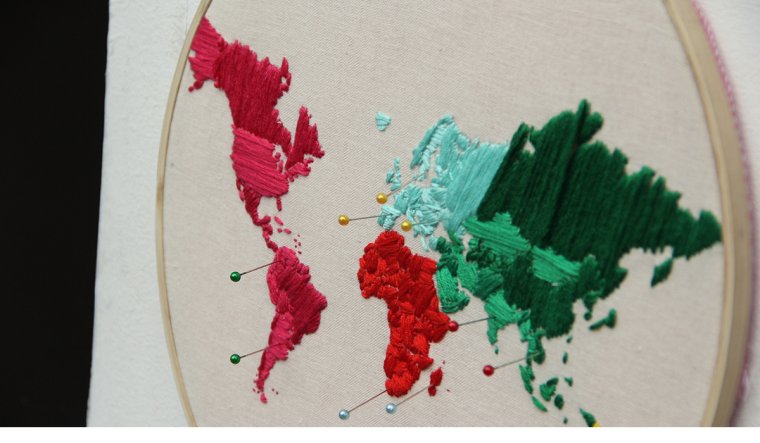In our Craft Capsules series, authors reveal the personal and particular ways they approach the art of writing. This is no. 160.

In one of his famous letters, John Keats wrote, “A Poet is the most unpoetical of any thing in existence, because he has no Identity—he is continually in for—and filling some other Body.” In another letter, he coined the term negative capability: “when [a hu]man is capable of being in uncertainties, Mysteries, doubts, without any irritable reaching after fact and reason.” Keats’s idea was that a poet should be a kind of negative force—that only by emptying herself of herself could she make enough room to be fully inhabited by whatever it is she’s contemplating.
Whenever I’m feeling uninspired, I think: Somewhere, somebody is doing something right now. You may say this sounds less like a hype mantra and more like the mother of all mediocre movie taglines; you would not be wrong. Nevertheless, this thought is, for me, a surefire poem-generator—lifting me up, up, and away from the well-worn facticity of myself, out into the contemporaneous “Mysteries” of unknown others and their unknown lives.
So think of the following as a negative capability tune-up, an exercise in temporary self-displacement—an empathic immersion program, if you will.
Begin by simply imagining some unknown Somebody, who, Somewhere on earth, is, even now, as we speak, in the middle of doing Something. The trick is to make the Somebody, Somewhere, and Something as specific, realistic, and concrete as possible. The resulting vignette can—and in fact probably should—be quiet, intimate. Whatever is currently taking place in this imagined person’s world likely won’t find its way into any newspapers. What you’re being asked to conjure here is an ordinary moment in an ordinary life in the ordinary process of unfolding on some ordinary stretch of the planet.
Each stanza should have as its subject a new imagined Somebody. The poem can be as long as you want—but aim for a minimum of four different Somebodies, or four stanzas. In the space of one stanza, can your readers come to feel that they know each Somebody—or better yet, that they know what it’s like to be that Somebody—just through the well-chosen details you’ve put on offer?
Keats’s psychic porousness was not reserved for members of his own species, however: “If a Sparrow come before my Window I take part in its existence and pick about the Gravel,” he wrote. So in a variation on this exercise, you might make some or all of your Somebodies nonhuman. But “[n]either was Keats bothered,” Mary Oliver points out in A Poetry Handbook, “by the categories of animate and inanimate: his friend Richard Woodhouse records that Keats claimed he could ‘conceive of a billiard Ball that it may have a sense of delight from its own roundness, smoothness & very volubility & the rapidity of its motion.’” In true Keatsian fashion, then, your stanzas’ respective subjects might include, in addition to imagined humans, imagined nonhuman creatures and/or inanimate objects.
Whoever or whatever you choose to include, your stanza-long vignettes should be stocked with evocative details, concretely physical yet—at the same time, and to the same degree—emotionally intimate.
I love to take an object made all but invisible by its mundanity—an egg-shaped container of pantyhose, a lawn chair turned on its side—and break it open to expose the full dimensions of the human vulnerability it carries. Characters inhabit most of my poems, characters with idiosyncratic voices and points of view, characters as liable to be overlooked as their own pathos-rich furniture and knickknacks. One of my aims is to let these characters’ hidden stories come through; it’s astonishing how much narrative can be stored in someone’s set of novelty coffee mugs or arrangement of washcloths.
Many of my poems from peep (Waywiser Press, 2022) were—despite their marked dissimilarity in form and content—born of some version of the thought, Somewhere, somebody is doing something right now. The perspective of this one—“Formal Proof That the Universe Is Neither Cruel nor Kind, and That This Is the Greatest Conceivable Horror,” an early draft of a poem in my book—is dispersed among tenants of a single apartment house during a single moment in time. The reader is given access to each tenant only by way of the odd physical detail; the tenants don’t have much more access to one another or to themselves. The “conclusion” of the poem’s “proof” delivers readers to a place of brutal remove, an “out there” with no mind to pay to the muffled phrases lost in the moment they’re uttered.
The “out there” with no capacity to pay us any attention is, for me, inextricably linked to the urgency of these exercises in negative capability, because whatever can be said about the universe-at-large, we have minds and imaginations to lavish on each other, and it’s in all of our best interests, I think, to try and really use them. As Percy Bysshe Shelley writes in “A Defense of Poetry,” a “[hu]man, to be greatly good, must imagine intensely and comprehensively; [they] must put...[them]self in the place of another and many others.” Or in the words of contemporary philosopher Martha Nussbaum, from her article “Democratic Citizenship and the Narrative Imagination”:
The imagining [that the poet] demands promotes a respect for the voices and the rights of others, reminding us that the other has both agency and complexity, is neither a mere object nor a passive recipient of benefits and satisfactions. At the same time, it promotes a vivid awareness of need and disadvantage, and in that sense gives substance to the abstract desire for justice.
Danielle Blau’s debut full-length poetry collection, peep, was selected by Vijay Seshadri for the 2021 Anthony Hecht Prize and was published in both the United States and the United Kingdom by Waywiser Press in 2022. Her nonfiction book, Rhyme or Reason: Poets and Philosophers on the Problem of Being Here Now, is forthcoming from W. W. Norton.
Art: Andres Gomez







